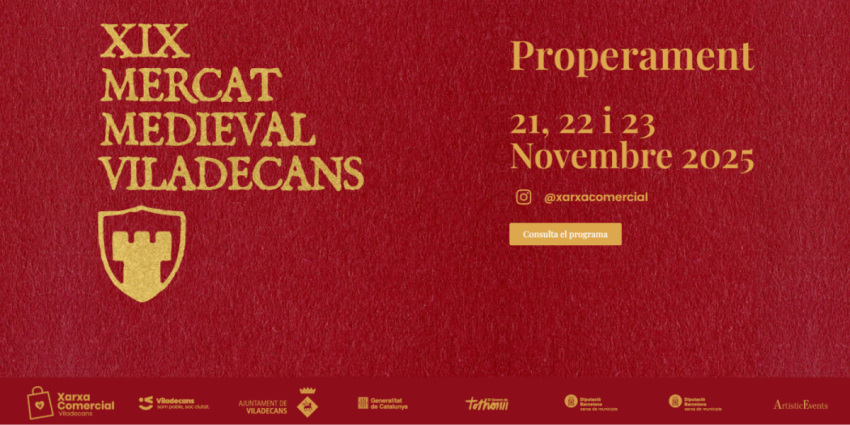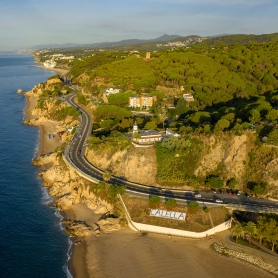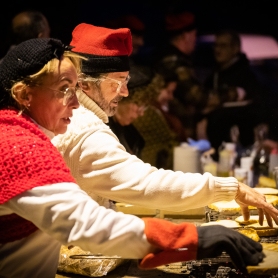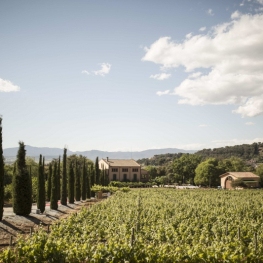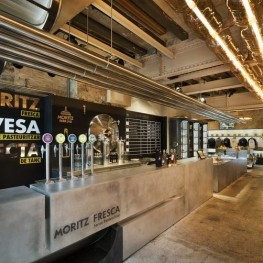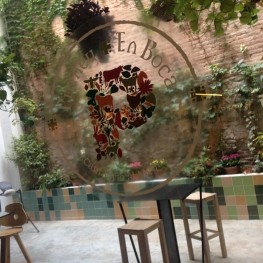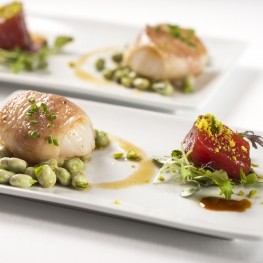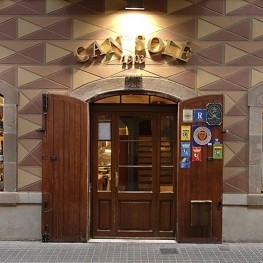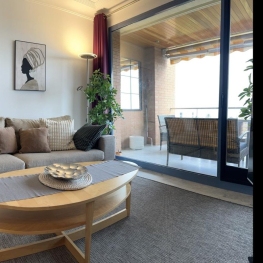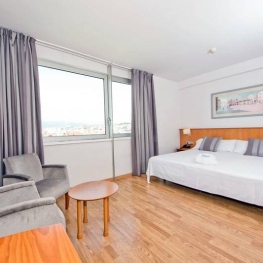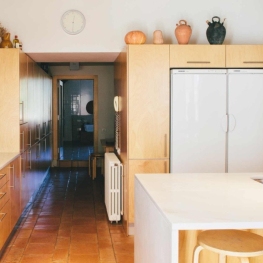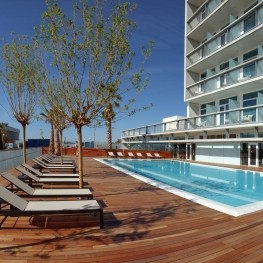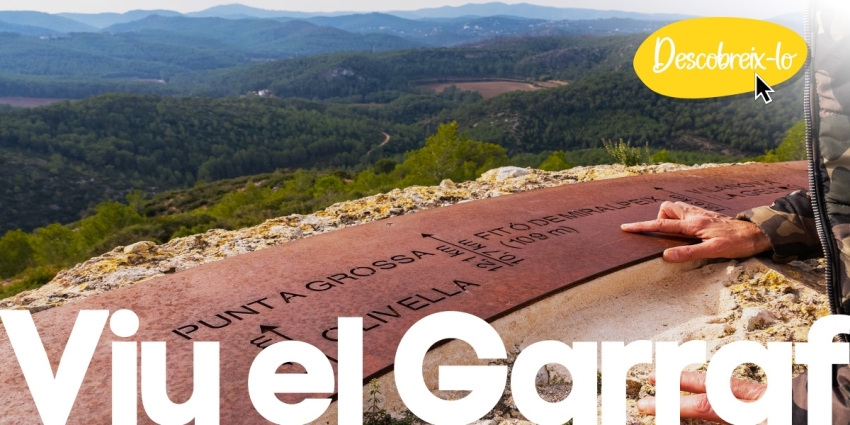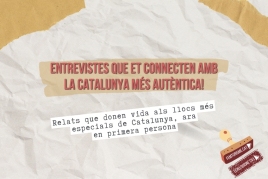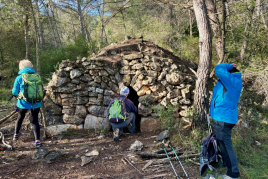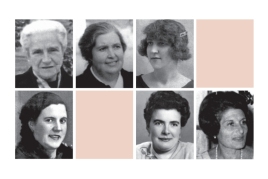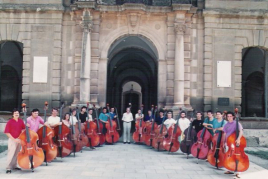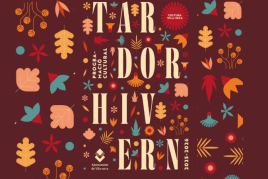Know El Masnou, land of the sea
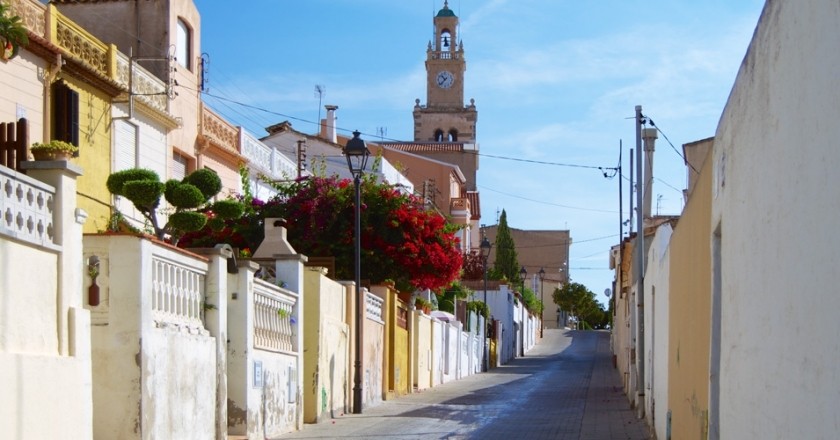
This itinerary is part of an ambitious and stimulating project that aims to rehabilitate and adapt highly relevant elements of Masnou's local heritage, such as the Water Mine, the Culture House and the Lake Park. Likewise, it wants to value the architectural, artistic and urban wealth of the city.
You can follow the route through the App el Masnou, Tierra de Mar, available at this link.
We start!
Bellresguard farm
The Bellresguard estate, which was promoted by Romano Fabra and Puig and his wife Marcelina de Monteys, is currently made up of three different spaces: the mansion, the romantic garden or Parque del Lago, and the viewpoint.
The palace, known as Casa del Marqués, was built between 1902 and 1904 as a summer residence. It is a French neoclassical style building, the work of the Barcelona architect Salvador Vinyals. During the Civil War he was seized, the headquarters of the Confederal Laboratory of Experimentation was established, and finally he was bombed. It passed into municipal hands 1989.
The Lake Park, annexed to the house, stands out for the small central pond and the cave with a waterfall. The viewpoint, close to the main road, consists of a wide balustrade that offers excellent views of the sea.
Romano Fabra y Puig belonged to a lineage of politicians and industrialists linked to the Hilaturas Fabra i Coats. He was a great patron in the municipality and in 1922 King Alfonso XIII granted him the title of Marquis del Masnou.
Currently the palace houses the Casa del Marqués Business Center, and the Lake Park and the Bellresguard viewpoint are public parks.
Can Teixidor
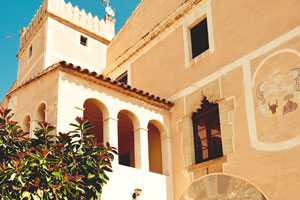 On the seashore stands the Can Teixidor farmhouse in a pre-eminent position . Its architecture is assimilated to that of a fortified farmhouse, with dependencies typical of an agricultural and residential operation: house, chapel, cellar and a large raft that gave water to a flour mill.
On the seashore stands the Can Teixidor farmhouse in a pre-eminent position . Its architecture is assimilated to that of a fortified farmhouse, with dependencies typical of an agricultural and residential operation: house, chapel, cellar and a large raft that gave water to a flour mill.
The discovery of pottery from the Roman period shows that it has been a desired place since very ancient times. The extensive winery testifies to the importance that the municipality had in the cultivation of vines and the production of wine, especially during the 17th and 18th centuries.
Can Targa
In what was the old Alella neighborhood of the sea, we find the Can Targa farmhouse (16th century) and a group of nearby houses that have their origin in the 18th century. It is from 1840 when this neighborhood is annexed to the young municipality of Masnou -independitzat of Teià fifteen years before- after a long and turbulent road that began in 1821.
The name of Can Targa does not come from one of its most famous owners, Captain José Sampera, but from the renegade pirate knight he captured.
One of the last heirs of the house, José Ventura y Estapé, installed a distillery that popularized La Liebre anise, and also served, in jugs, a drink made with white rum, gin, muscat, anise and mint.
The main claim of the farmhouse was a source that was at the bottom of the garden, where the people of Mason were going to take the fresco and to which the Masnovian poet Josep Pujades y Truch dedicated a poem.
It is currently a municipal facility, which houses the Can Targa Occupational Therapy Service for people with mental disabilities.
Can Xala
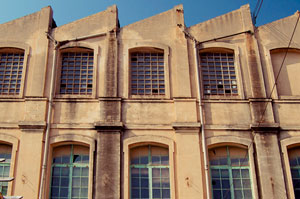 Sailing has been a fundamental activity in Catalonia and Masnou is a good example.
Sailing has been a fundamental activity in Catalonia and Masnou is a good example.
Since 1841 José Sensat's factory has been dedicated to spinning, weaving and manufacturing boat fabrics. Vapor Sensat was one of the first factories in Catalonia where a steam engine was installed, but in 1883, due to the decline of the sailing marina, the company is absorbed by its main competitor, the Estapé Factory, owned by Pau Estapé Maristany and founded by his father, Gerard Estapé, around 1851. Then the building began to receive the family nickname "Can Xala".
Streets of San Pedro and Doctor Jaume Curell, and the Sixty Stairs
The original nucleus of El Masnou was formed around the church of San Pedro, between the hills known as the Mosque and the Roca de Xeix.
The orography of the land, with steep slopes that are overcome with slopes or stairs, has conditioned the development of the municipality and its urban planning. A good example of this ancient urban layout of streets parallel to the coastline are the streets of San Pedro, San Francisco de Asís and its extension, Dr. Jaume Curell Sampera - formerly Calle de la Ginesta. Originally all these houses enjoyed a magnificent view of the sea.
At the top of the Roca de Xeix is reached by the Sixty Stairs, which have converted a pedestrian street with a steep slope, formed by a succession of steps and landings with a very characteristic sardinel brick finish. This point, current Avenida de Juan XXIII, was the old Alella road and constituted the division of the parishes of Sant Feliu de Alella and Iris de Teià.
According to some popular sources, near this place would be the one that gives the town its name, a meek novel, collected in a document from the year 1055. Other versions place this one in Can Malet.
St. Peter's Church
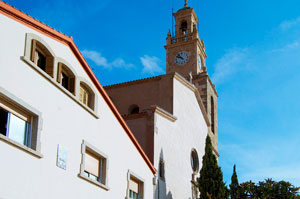 In lands that formerly belonged to Teià, a population center was formed throughout the 17th and 18th centuries around the hill where the Church of San Pedro stands today .
In lands that formerly belonged to Teià, a population center was formed throughout the 17th and 18th centuries around the hill where the Church of San Pedro stands today .
The impossibility of these inhabitants to attend many liturgical services - due to the distance in the parish church of San Martín in Teià - motivates the meeting, in 1769, of one hundred and sixty heads of families in the Francisco Mora hostel to ask the bishop for permission to build a church. The fishermen and dizzy guild contributed financially to the construction of this first temple, which was consecrated in 1783, the day of the festivity of its patron Saint Peter. With the approval of King Ferdinand VII and the approval of the ecclesiastical authorities, the ownership of his own parish was finally obtained, independent of that of San Martín de Teià (1818).
charity house
In a historic moment in which public administrations did not foresee caring for the underprivileged, the mayor Pablo Estapé Maristany promoted the creation of a charitable asylum dedicated to assisting the homeless, the elderly, homeless and destitute children.
A part of the financing comes from the City Council, although most of it is obtained from private donations, among which stands out that of the merchant Pedro Grado Maristany, as well as the periodic quotas of the members of the El Masnou Charity Society, which is established in 1899.
Ocata school
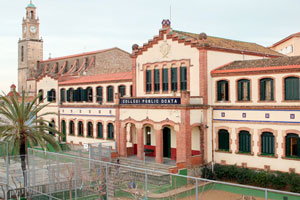 The Ocata School is the result of the concern of the Masnouenses for a public education. Thus, in 1838 a commission had already met to educate 100 abandoned children due to the lack of means to pay the teachers' salaries. Two years later the free primary school classes for boys would begin, and from 1848, also for girls.
The Ocata School is the result of the concern of the Masnouenses for a public education. Thus, in 1838 a commission had already met to educate 100 abandoned children due to the lack of means to pay the teachers' salaries. Two years later the free primary school classes for boys would begin, and from 1848, also for girls.
The poor conditions of the rental house on Calle del Rastillo -now Jaume I-, which was used as a public school and the donation of land by Miquel Amat Lluch, favor the construction of a new building from of 1904. The works are financed thanks to a municipal loan agreed with the neighbors.
The building is the work of the municipal architect Bonaventura Bassegoda i Amigó, also author of the Casino de El Masnou, the expansion of the new cemetery and some pantheons. Classes begin during the 1905-1906 school year, and in 1909 King Alfonso XIII awarded the title of Most Illustrious Villa El Masnou for his educational work.
From the origins, schooling is of both sexes and hence it was known as the Ocata Mixed School. The primitive building, of symmetrical composition, intended the north wing for boys and the other for girls. In 1967 an upper floor was incorporated to house new classrooms.
Can Millet
Can Millet is the private residence of a family of captains of ships of the Masnou, among which is José Martí Casals. At the end of the 19th century, the family commissioned the house to be renovated by the architect Gaietà Buïgas, who also authored the Masnou de la Casa Benéfica and the Columbus monument in Barcelona.
It is worth noting the decorative richness of the façade, especially the floral and geometric motifs that frame the openings, the sgraffito of garlands under the cornice and the openwork balustrade, as well as the small landscaped courtyard in front.
Freedom square
The Plaza de la Libertad is an emblematic place of the town that is configured after the bourgeois revolutions of September 1868, for which it bears this name. For this, it has been linked to political and social movements, especially before the Second Republic.
It has always maintained a recreational and recreational character, as opposed to the Plaza de la Constitución -now the Old Market- or Ocata, which is more commercial.
casino
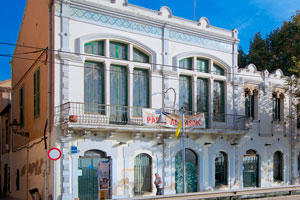 A part of the current building takes advantage of the main body of Can Fontanills, also known as Older. On the door and window lintels you can see the Fontanills family crest, whose symbol is a fountain.
A part of the current building takes advantage of the main body of Can Fontanills, also known as Older. On the door and window lintels you can see the Fontanills family crest, whose symbol is a fountain.
This 17th century building and the old attached defense tower, which was square in plan, although they existed between 1876 and 1887, when the Trade College was installed, where the teacher Francisco Flos y Calzado taught classes .
Later, the Casino Cultural and Recreational Society, founded in 1875, settled in this building and transformed it giving it its current appearance. The architect Bonaventura Bassegoda i Amigó designed this modernist extension in 1902, building the café, the roundabout, the billiard and game rooms. In 1904 the works were completed with the inauguration of the theater for the party room, the most relevant element of the complex.
The decorative elements of the polychrome stained glass, the tiles and the lattice with the anagram of the owner at the time, Miquel Amat Lluch, stand out.
town hall
The independence of the consistory of El Masnou, which had begun in 1812 as a result of the new legality arising from the Cádiz Constitution, was achieved in 1825.
In 1844, faced with the need to build a town house, the mayor Joan Rubis commissioned Miguel Garriga y Roca to carry out the project on land that the Gaspar Malet family acquired in 1755.
Of the façade the decorative details in terracotta stand out, the two sculptures that symbolize justice and abundance, and the two reliefs that flank the access door and which refer to what were then the main activities of the population: agriculture - the cultivation of the vineyard- and the marinera.
Can Malet
Can Malet became one of the largest properties in the municipality, made up of more, a chapel, the caretakers' house, a garden with a pond, orchards, was, stables, warehouses and vineyards, among others.
Only the façade of the landlord's house, part of the gardens, a lintel dated 1736 and the IHS monogram that corresponds to the chapel of San Antonio de Padua are conserved of the complex, a construction that was lost in the successive renovations and extensions.
It is currently a municipal facility, headquarters of the Casal de Gent Gran de Can Malet.
Culture House
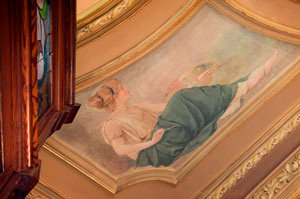 At the Masnou of 1900, the construction of this Indian house was a stylistic innovation, since it responds to the taste for Islamic architecture of its owner, Jaume Sensat and Sanjuan, who had lived two years in Egypt.
At the Masnou of 1900, the construction of this Indian house was a stylistic innovation, since it responds to the taste for Islamic architecture of its owner, Jaume Sensat and Sanjuan, who had lived two years in Egypt.
The rebuilding project is signed by the well-known master builder Pedro Andreu. The exterior of the building concentrates the ornamental riche, highlighting the viewing platform on the corner, with lobed arches and a ceramic scale covering.
Adra street
This street, which bears the name of a town in Almería with which the Masnouenses used to trade in cabotage, is one of the oldest streets in the municipality. Located next to the sea -the front courtyards were replaced by blocks of flats-, it still preserves the structure of the body houses, a typology of single-family dwelling typical of many Maresme towns, with ground floor and floor and with the patio in front.
In this sector, on the beach, the jobs in the shipyards, the jobs of the fishermen and the traffic of loading and unloading of the boats coexisted. In the middle of the XIX century, in the shipyards, three riverside carpenters or boat builders worked: Pere Sust, Pablo Jubany and los Carreras (Juan Mont Carreras y Calzada and their sons Benito and Manuel). Very often, two-masted sailboats such as brigantines and Pollacra were built, with 50 to 300 tons of tonnage.
Ocata Square
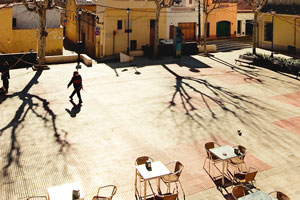 This square was the location of one of the city's markets; the other was located in the Plaza de la Constitución - more recently known as the Old Market.
This square was the location of one of the city's markets; the other was located in the Plaza de la Constitución - more recently known as the Old Market.
The main theory about the origin of the name Ocata speaks of the immigrant population of the Roussillon municipality of Leucate, in France. The other refers to Hecate, a Greek divinity.
In recent times, Ocata Square has become a meeting and celebration place for social and cultural events in the municipality.
Cal Ros de las Cabras
Cal Ros is a villa from Roman times that functioned as a center for the production of wine and ceramics between the 2nd and 5th centuries AD. It was discovered in 1899 by the owner of the estate, Thomas Morrison - a British citizen settled in Catalonia for business reasons - in finding a polychrome mosaic, walls and lots of pottery.
The archaeological interventions have been sporadic and uneven, but they have allowed documenting the residential area of the town with different mosaics and stuccoed walls, as well as the rustic part, intended for workshops and storage of agricultural tasks: amphora furnaces, warehouses and a warehouse for hurt - very large spherical clay containers for storing and transporting food - and landfills.
Of the site, highlights the discovery made by J. Serra Ràfols (1946) of a mosaic found in the Museum of Archeology of Catalonia and the finding of a bronze seal, with the inscription Publi Valeri Euryali, which gives its name to the first Masnoví known.
The amphoras made in Cal Ros were used to package the famous wine from Layetania and transport it by sea to the rest of the Roman Empire, to areas as far away as northern Gaul -current Germany-.
The name Cal Ros de las Cabras refers to the settler who lived, Isidro Ramentol, who had blond hair and cared for the farm's goats.
Source: El Masnou City Council
You may also be interested in: Guided tours of the towns and cities of Catalonia
What to do
Pessebre Vivent de Sant Fost
Sant Fost de Campsentelles (a 8.3 Km)The village of Sant Fost de Campsentelles located in vallesano hillside where…
Celler Can Roda
Santa Maria de Martorelles (a 7.8 Km)Next to the Maresme, among the leafy Mediterranean landscapes, is our winery,…
Vols Turístics
Barcelona (a 14.8 Km)Have you ever dreamed of flying like a bird, exploring the sky…
Where to eat
Fàbrica Moritz Barcelona
Barcelona (a 16.9 Km)The Moritz Factory Barcelona is a unique space, divided into three floors,…
Restaurant Windsor
Barcelona (a 16.5 Km)The Windsor restaurant, located in Barcelona, is a benchmark of contemporary Catalan…
Where to sleep
Let's Holidays Barcelona
Barcelona (a 14.2 Km)We offer more than just a stay... Let's Holidays offers you a…
Aparhotel Atenea Vallès
Granollers (a 13.6 Km)The Atenea Valles Aparthotel Granollers is located in the commercial center of…
Ca l'Andreu Ecoturisme
Tiana (a 4 Km)Spending a few days in an authentic 15th-century farmhouse is priceless. Renovated…
Atenea Port Barcelona Mataró
Mataró (a 12 Km)A new hotel located in the port of the maritime city of…

